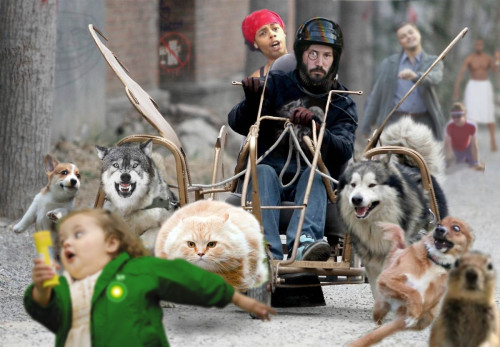 |
| The smart villain knows when she is outmatched! |
In order to convert a villain from a mere Big Bad End Guy into a true archenemy, you have to keep him/her/it alive through more than one encounter. Any chump can fight a group of heroes once, but it takes something special to survive the first encounter in order to harass and/or return to seek vengeance at a later date. Surviving run-ins with the forces of good can be tricky, especially in a medium like D&D, which has a very high villain mortality rate.
In fiction, authors can use any number of devices to ensure their villains are long-running antagonists and foils to their heroes. The author has complete control to ensure their clashes end however they wishe. In D&D and other tabletop RPGs, there is a strong element of uncertainty created by the dice and the inclusion of the players as creative forces in the story. In over three years of running my game on a bi-weekly basis, my players have had a total of 5 major antagonists survive their first encounter. Only three of those antagonists remain active, the others having been destroyed after their second run-in with the forces of righteousness... and one of the active ones was only seen standing on a distant hill (see "Lead from the Rear" below)
So, what techniques can a GM employ to ensure that his/her big baddies get away to fight again another day?
First and foremost, play your top villains smart. Intelligence was one of my must-have qualities for an archenemy. A smart villain will likely err on the side of caution. They will be tactically cautious upfront to help ensure their advantage before willingly engaging their foe. They will always have an escape plan in case something goes wrong, and, if possible, they will not wait until they are on the verge of death to use said escape plan. Here are some specific examples of smart villain tactics:
Lead from the rear: A wise antagonist, will likely send in his troops before wading into battle himself. Allowing others to throw themselves against the PCs can not only soften the heroes up a bit, but it can also let the big bad leader analyze and assess their capabilities from relative safety.
Git while the gettin's good: If you were losing a fight you didn't need to be in, how long would you stand and slug it out? Unless something major is keeping them there, I would have most smart villains head for the exit, or at least attempt to disengage and heal once they were drained to about half-strength. Really tenacious bad guys like barbarians might be a little more cavalier, but I'd still have them consider their options by about 25% health.
Decoys and quick escapes: D&D offers several magical options for getting out of a tight spot fast. From invisibility, to teleport spells, a villain has numerous panic-button options to chose from. Heck, even a wall of bees might do the trick in a pinch. (That's not really a spell, though it should be!) The inherent quick escape abilities of creatures like mindflayers, vampires or liches makes these monsters excellent options for recurring villains. Vampires and liches can only be permanently destroyed if respectively found in their coffin or phylactery (horcrux for you Harry Potter fans). Smart undead would set up decoy versions and keep the real thing well hidden. For more mundane villain sorts, like human warlords or the like, a spring-loaded portcullis or sudden rush of minions might do the trick, though it is far from guaranteed.
Call in Miracle Max: If worse comes to worse, a villain with loyal followers and a little cash could always rely on them to resurrect his/her arrow-riddled corpse. Even a relatively low level arch might have access to a spell like reincarnation... In fact, it might be really amusing to have some vain and villainous duke brought back in the body of a kobold or something.
 |
| These guys know what I'm talkin' about! |

We are in dire need of good villains. :)
ReplyDeleteI agree with all of your statements! In addition I would throw in "A stronger bad guy." Make the bad guy much more powerful than the PCs. In their first encounter he may disregard them as pitiful and not worth his time. The characters must work their way up to being powerful enough to defeat him.
ReplyDelete"Just missed him" the PCs arrive at a ravaged and burnt town, the few survivors tell of the baddie, who raided the town with his minions only a day ago.
"preoccupied players" The baddie uses some distraction to occupy the players. His forces attack the keep from the front while he sneaks through the rear, stealing the(person/thing), leaving behind only one witness or a calling card.
"taking a hostage" Nothing says "evil as sin" like standing behind a human shield of innocence.
"politically superior" The PCs uncover a political figure is the mastermind but have no hard proof. Who will the authorities believe?
All excellent suggestions! and solid tactics to help ensure a getaway. That is, unless one of your PCs ignores the knife held at her best friend's throat and tries to blast the bad guy anyway.
DeleteMy upcoming Tuesday post, "I for Introductions" will hit on the use of overpowering baddies to give the heroes something to grow into.
Your use of images is great! I love this post. Too often I've encountered wishy-washy villains with no substance. Another great part about villains is building them up before the heroes ever meet them.
ReplyDeleteGood luck with the challenge!
Dianna Fielding
Sociologyfornerds.com